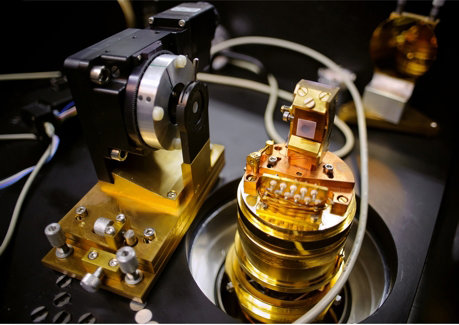A new dimension in materials research
The electronic and magnetic properties of thin films depend on the number of atomic layers which are stacked on top of each other
In the future, physicists will be able to follow a new lead in their search for new materials for electronic components, for example. An international team of researchers headed by scientists at the Max Planck Institute for Solid State Research in Stuttgart is the first to accurately observe how the physical properties of a substance – or to be more precise of the metal oxide lanthanum nickel oxide – change when it is used in two-dimensional, instead of three-dimensional form. In fact, a film consisting of two layers of material exhibits completely different electronic and magnetic effects when cooled to very low temperatures than does a film comprising four layers. The ability to control the physical characteristics via the dimension as well opens up new possibilities to identify materials from which the chips of the future could be made.

The semiconductor industry is gradually reaching its limits. As it continues to decrease the size of electronic components, conductor tracks and transistors are probably soon going to shrink to the size of atoms. It is almost impossible to control the manufacture of structures as tiny as this with the methods in use today. Moreover, when they are in operation, they generate so much heat due to their electrical resistance that they would probably quickly lose their shape. The era of semiconductor electronics could therefore come to an end in the foreseeable future. Metal oxides might then be a viable alternative. This class of materials includes not only those which lend themselves because of their magnetic properties – some metal oxides are also superconductors that conduct electricity with zero resistance.
An international team working with Alexander Boris and Bernhard Keimer at the Max Planck Institute for Solid State Research in Stuttgart is now pointing the way to a new method of custom-designing the properties of metal oxides. The researchers, including scientists at the Max Planck Institute for Metals Research, the Paul Scherrer Institute in Villingen/Switzerland and the University of Fribourg, also in Switzerland, are the first to have accurately worked out how the spatial dimension of a material influences its physical behaviour. “We are thus selectively tweaking the control variable that physicists have so far been able to control only imprecisely,” says Bernhard Keimer, Director at the Max Planck Institute for Solid State Research. Neither have they been able to find out what effect the dimension has among all the other factors which are involved in determining the electronic and magnetic behaviour. And the effect is huge, as the researchers have now discovered.
The scientists investigated the metal oxide lanthanum nickel oxide LaNiO3, which contains nickel in addition to the electronically inactive lanthanum and oxygen atoms. This composition was chosen not least because nickel is endowed with a special type of electron whose magnetic moments always make them good for physical surprises. This is scarcely noticeable in a massive block of nickel, however, and the same applies to all samples which are thicker than four layers of material, i.e. also those which measure only a few nanometres. In this form, lanthanum nickel oxide belongs to the metallic conductors, and the magnetic moments of the electrons move about like twirling bar magnets. This remained the case when the physicists cooled a sample comprising four layers of the material to a temperature of almost absolute zero at minus 273 degrees Celsius.
